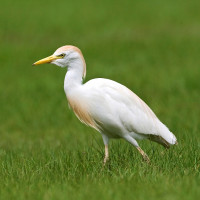Opis
First regular French wintering site for one of the American subspecies of the bernikla obrożna, the pale-bellied one (Branta bernicla hrota). It is the largest haven on the west coast of Cotentin, it is made up of sandbanks, 870 hectares of mudflats at low tide and salt meadows grazed by sheep. These tidal flats and sandy areas that become exposed at low tide are a very attractive refuge for overwintering shorebirds.
_________________________
Français: Il s'agit d'un grand estuaire paisible où se découvrent à marée basse des bancs de sable, des vasières et des prés salés. Premier site français régulier d'hivernage de l’une des sous-espèces américaines de la bernache cravant, celle à ventre pâle (Branta bernicla hrota).
C'est le plus vaste havre de la côte ouest du Cotentin, il est composé de bancs de sable, de 870 hectares de vasières à marée basse et des prés salés pâturés par les moutons. Ces vasières et zones sableuses découvertes à marée basse, constituent un refuge très attractif pour les limicoles hivernants.
Szczegóły
Dostęp
The easiest way is to park in front of the Jules Gommés restaurant. There is a part on the left to the old station which is easily passable (tarmac road) but on the right part you can go into the marsh and boots are necessary.
_________________________
Français: Le plus simple est de se garer, route de la mielle en face du restaurant le Jules Gommés. Il y a une partie sur la gauche jusqu'à l'ancienne gare qui est facilement praticable (route goudronné) mais sur la partie droite vous pouvez aller dans le marais et des bottes sont nécéssaires.
.jpg)
.jpg)


